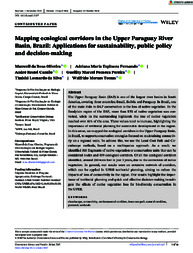Mapping ecological corridors in the Upper Paraguay River Basin, Brazil: Applications for sustainability, public policy and decision?making
Mapping ecological corridors in the Upper Paraguay River Basin, Brazil: Applications for sustainability, public policy and decision?making
Author(s): OLIVEIRA, M. da R.; FERNANDO, A. M. E.; CAMILO, A. R.; PEREIRA, G. M. F.; SILVA, T. L. da; TOMAS, W. M.
Summary: Abstract: The Upper Paraguay Basin (BAP) is one of the largest river basins in South America, covering three countries: Brazil, Bolivia and Paraguay. In Brazil, one of the main risks to BAP conservation is the loss of native vegetation. In the floodplain region of the BAP, more than 13% of native vegetation was converted, while in the surrounding highlands the loss of native vegetation reached over 61% of the area. These values tend to increase, highlighting the importance of territorial planning for sustainable development in the region. In this sense, we mapped the ecological corridors in the Upper Paraguay Basin, in Brazil, to support conservation strategies focused on maintaining connectivity on a regional scale. To achieve this, we use the Least Cost Path and Circuitscape methods, based on a multispecies approach. As a result, we identified 303 fragments of native vegetation or conservation units that can be considered nodes and 859 ecological corridors. Of all the ecological corridors identified, around 288 were lost in just 3?years, due to the conversion of native vegetation. In general, our results were an extensive network of corridors, which can be applied in UPRB territorial planning, aiming to reduce the impacts of loss of connectivity in the region. Our results highlight the importance of territorial planning and quick and effective decision?making to mitigate the effects of native vegetation loss for biodiversity conservation in the UPRB.
Publication year: 2024
Types of publication: Journal article
Unit: Embrapa Pantanal
Observation
Some of Embrapa's publications are published as ePub files. To read them, use or download one of the following free software options to your computer or mobile device. Android: Google Play Books; IOS: iBooks; Windows and Linux: Calibre.
Access other publications
Access the Agricultural Research Database (BDPA) to consult Embrapa's full library collection and records.
Visit Embrapa Bookstore to purchase books and other publications sold by Embrapa.

